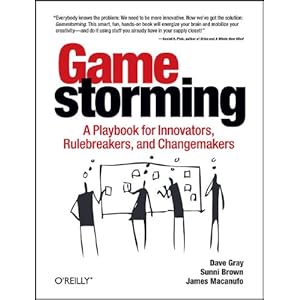 The concept of work is changing. The “assembly line” philosophy where workers are treated as a “cog in a machine”, performing set tasks or processes without the need for thought is a waste of resources. Technology can complete these jobs more efficiently, or the work can be outsourced abroad for a fraction of the cost. To justify the high wages of a post-industrial employee, people have to be capable of so much more. We need to be creative, to solve problems and to craft meaningful relationships. To learn how to meet these demands proficiency and in a way you'll enjoy, read “Gamestorming” by David Gray, Sunni Brown and James Macanufo.
The concept of work is changing. The “assembly line” philosophy where workers are treated as a “cog in a machine”, performing set tasks or processes without the need for thought is a waste of resources. Technology can complete these jobs more efficiently, or the work can be outsourced abroad for a fraction of the cost. To justify the high wages of a post-industrial employee, people have to be capable of so much more. We need to be creative, to solve problems and to craft meaningful relationships. To learn how to meet these demands proficiency and in a way you'll enjoy, read “Gamestorming” by David Gray, Sunni Brown and James Macanufo.
“Gamestorming” contains nearly a hundred examples of games that can be used in all stages of the problem solving process. “Opening” games create relationships, build a productive atmosphere and encourage open mindedness. “Exploring” games encourage group investigation and different points of view. “Closing” games focus all the ideas and viewpoints into a precise concept or an actionable plan.
Each example game is carefully detailed, including the required number of people, equipment and duration. The games are described, step-by-step, with advice on how to avoid traps and dead-ends in conversation, whilst encouraging productivity and ideas on extending the game if required.
For those interested in the theory behind “Gamestorming”, a detailed description of exactly what makes certain games applicable to business, how to create games and the essential concepts that separate a productive game from a waste of time.
Personally I found the book packed with useful ideas, and the concepts behind creative play fascinating. The frequent freehand illustrations add a great deal to the text and explain the occasionally complex ideas effectively. The section on core skills provides great information on data collection and presentation that improve communication skills, even without playing a single game.
The book closes with an anecdote describing the results of a Gamestorming seminar in summer 2009, where the simple coffee cup was re-invented and a marketing concept was born, attracting sponsorship from the coffee giant, Starbucks. As I put the book down I find my mind racing, filled with a sense of excitement, eager to “play” the games that’ll create new ideas, solve problems and improve our business.
Gamestorming - Book Review
